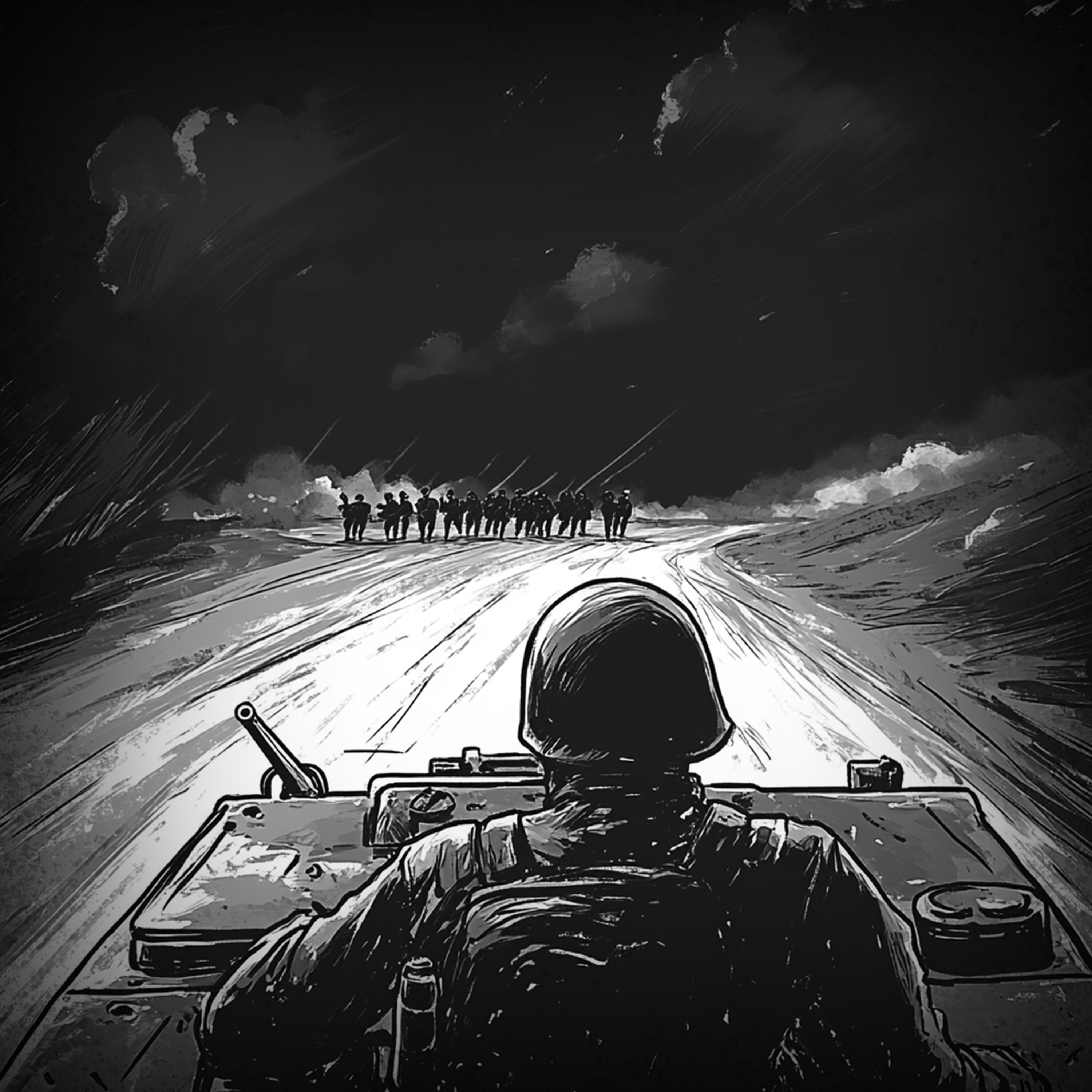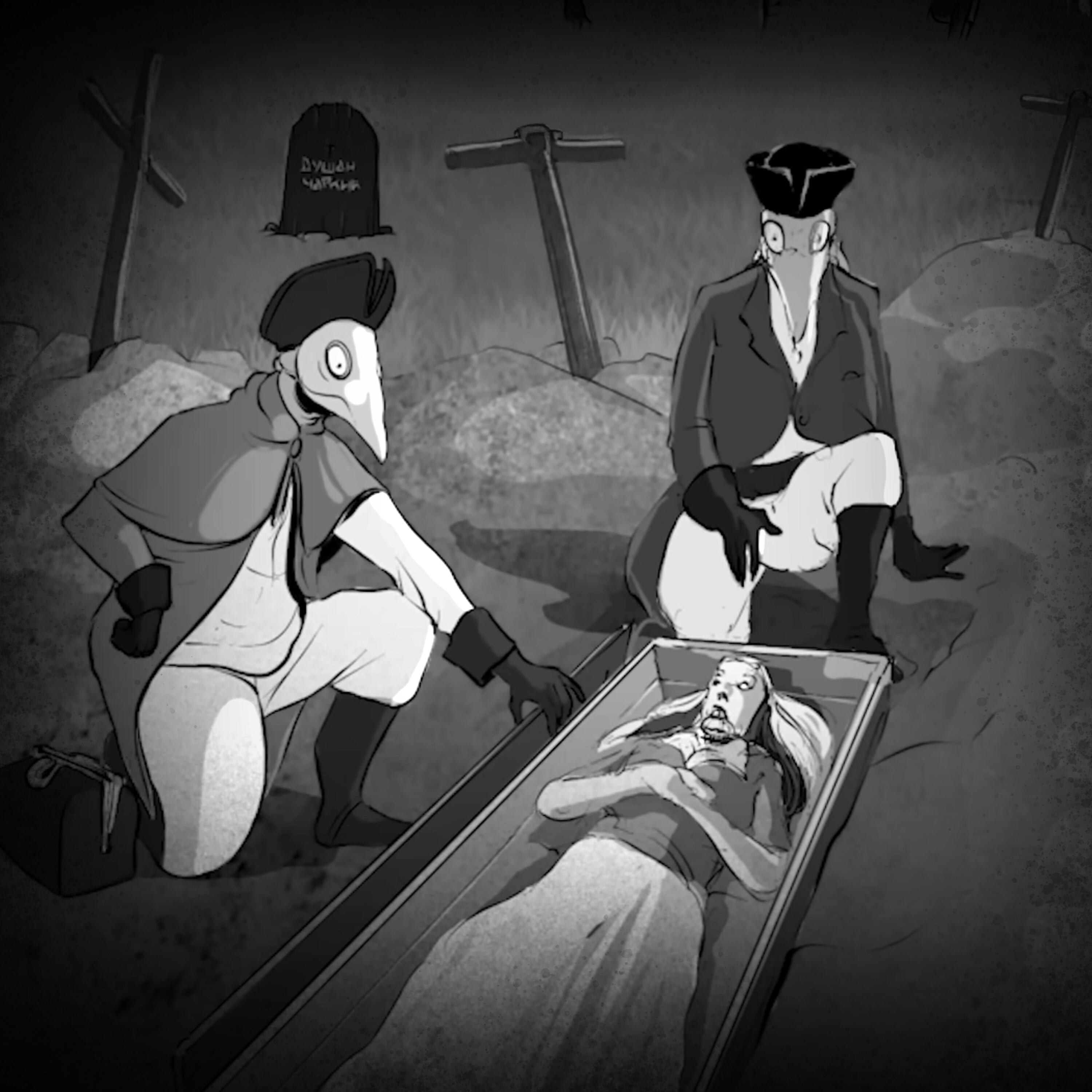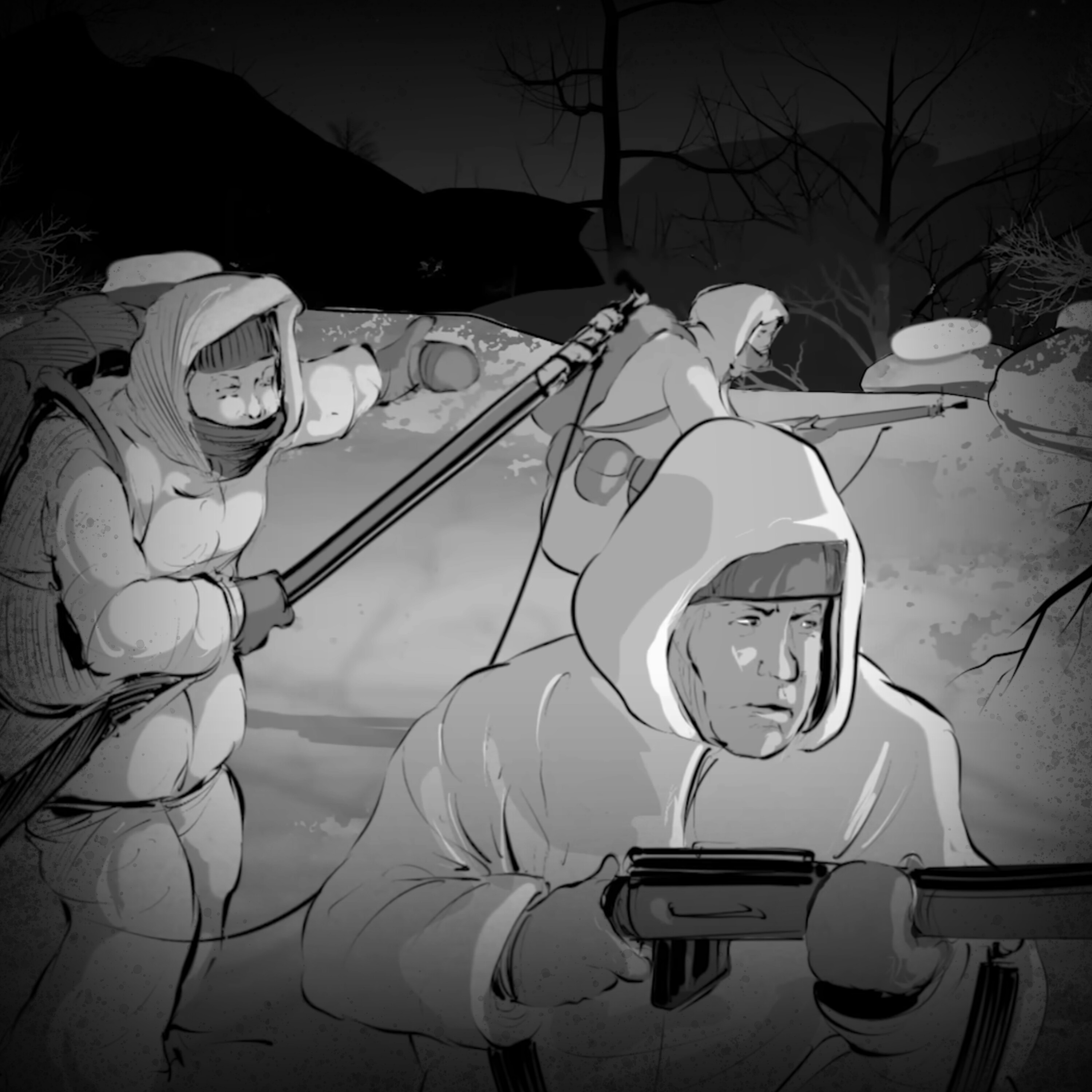An Invisible Hand
Stories of bizarre coincidences.
See Privacy Policy at https://art19.com/privacy and California Privacy Notice at https://art19.com/privacy#do-not-sell-my-info.
Press play and read along
Transcript
In his heart, a man plans his course, but it is the Lord who guides his steps.
If an unseen power can guide a man's steps, do we think this verse from the book of Proverbs would include stopping a trigger from being pulled when the gun was facing the wrong man?
Or what about giving the mother of a missing pilot a dream about exactly where the army could find her son?
If not divine intervention, what would you call it? Coincidence or luck? Maybe it's just fate.
Whatever it is, the idea that unseen forces beyond our understanding can influence the outcome of our lives is a belief shared by millions. No, billions around the world.
Certainly, these beliefs are held most strongly by those who have had such unexplained experiences, which no less include the men who returned home from the battlefield with very unusual stories.
Pulled straight from the battlefields of the Second World War, these following stories are only a few.
Stories so bizarre, it is as if an invisible hand was somehow involved in changing the course of history.
I'm Luke Lamana, and this is Wartime Stories.
So,
after he got out of the woods, Matt just flew home to New York. He thought about calling the authorities, but what could he tell them?
It was a guy out in the woods who followed him for three days and 30 miles.
It's not as if the man did anything wrong.
All he did was asking that same question
over
and over
and over again.
Do you know how to get to Belle's Canyon?
Oh, that's scary, Uncle Jack. Wow, I don't like that story.
Oh.
Those coyotes have good timing
what about you dad do you know any scary stories
scary stories
no
no darling i i um
i've come to mention it
there is something
that happened uh when i was in france
Not really a scary story, but just
something
I've never been able to explain.
So I've told you girls before that I served with the Royal Lancers
during the invasion of Normandy.
This first story was shared with me a while back by one of your fellow listeners, Kat.
In it, she recalls a peculiar memory from her childhood in which her father a British Army veteran of the Second World War, shared a strange story from his time fighting in France.
Kat, if you're listening, I hope you did your father's story and his service justice.
The story begins with Kat and her family taking a trip to meet up with some friends at their cabin in Arrowhead, California.
As the sun dipped below the horizon, they all gathered around the roaring campfire and engaged in the time-honored tradition of telling scary stories.
When Kat and her sister asked their dad if he had any spooky tales of his own, the Army veteran fell silent, now deep in his own thoughts.
While it wasn't a ghost story, he said that there was something that happened during his time in the Army that had baffled him for many years, something he just couldn't explain.
This came as a surprise to the two girls. Like many veterans, their father rarely spoke about his experiences during the war.
They knew he fought in the Normandy campaign and across Europe with the British Royal Lancers. But other than that, they knew very little about his service.
Overcome with curiosity, the two little girls hung on their father's every word as he told the following story.
On June 6th, 1944, Kat's father landed on the beaches of Normandy, France.
While Kat wasn't able to recall all the specific details of her father's service history, Evidently the only Lancers that participated in the D-Day landings were the 24th Royal Lancers.
Overall, the Royal Lancers, such as the 12th and 9th Divisions, were involved in the war from the onset, being the British Army's Armored Reconnaissance Regiment.
They were often tasked with patrolling deep inside enemy territory to observe German positions and troop movements.
In their reconnaissance role, the Lancers utilized armored vehicles equipped with the latest and most sophisticated reconnaissance tools.
Their vehicles were designed to provide high mobility and protection, allowing the Lancers to operate effectively in various terrains, while simultaneously minimizing their engagement with enemy forces.
Because their purpose was to collect valuable strategic information, direct combat was usually avoided unless it became absolutely necessary.
However, as the war progressed, some Lancer patrols were eventually tasked with direct offensive operations against the Germans.
The 24th Lancers were one such specialized cavalry regiment and did not primarily serve as a reconnaissance unit. Instead, they were actively participating in frontline engagements with their Sherman.
As part of the 8th Armored Brigade, they were involved in significant combat operations following their landing at Gold Beach on D-Day.
This included fighting around key locations such as Puteau-on-Bessines and Viller-Bocage shortly after landing.
Their role was to engage in direct combat against German forces as part of the British Army's effort to push the German lines back during Operation Overlord.
One of their first objectives was to capture the city of Caen, which would ensure their supply lines and provide a strategic advantage.
Likely during this operation, Katz's father, seated behind the steering levers of his Sherman tank, accompanied by four other lancers as his tank crew, found himself setting out on another forward patrol.
Driving off into the French countryside, their small element moved toward the German position, quite possibly aiming to punch a hole in their defensive lines as the Allies advanced inland from the beaches.
And that's when something strange happened.
Forest is a nice change. Never liked the beach much.
Even less now. Don't think I'll bother with it once we get back home.
If we get back home.
Always the optimist, aren't you, Robert? Hold on. Did you see that?
What? A rabbit? No.
I could have sworn sworn I just saw...
Yes. Look.
Soldiers. Crossing the road ahead.
I see them. Germans!
Oh, come on, not now. Come on, Roberts! What are you doing?
Damn it, Roberts. Are you waiting for an invitation? I'm trying.
She won't go. There goes another one.
Come on. What's wrong with it?
Damn it, Robert. It's jammed or something.
Well then, clear it! I am. The damned pin must be stuck.
Boys, I don't mean to rush rush you, but we are currently being flanked.
Fix it, Robert. We've only got seconds.
Come on, you ragged piece of secure.
At some point during their patrol, being the lead vehicle, Kat's father suddenly noticed movement ahead of them.
The Lancers held their breath as they watched several men begin darting across the road one by one.
There were no other friendly units this far forward. These were enemy soldiers, and it looked like they were now moving to flank the Lancers' position for an ambush.
The tank's gunner made a fast decision, turning his machine gun to face down the road, hesitating only for a moment before squeezing down on the trigger. But nothing happened.
Suddenly, at some distance up ahead, they spotted enemy troops going across the road, one at a time, moving from cover to cover. When they turned the gun on them, it strangely wouldn't work.
The gun didn't appear to be jammed, and none of them could figure out why it didn't fire.
They kept trying to shoot each time they saw someone jump across the road, but the gun continually refused to fire. Kept checking the gun, couldn't find anything wrong.
Meanwhile, these enemy troops kept moving down the road from them, which they could only watch until the entire unit had crossed.
While Kat's father and the other men worked on getting the gun fixed, the enemy troops, thankfully, seemed to have left the area. No ambush ever came.
For their own safety, the Lancers were under orders to maintain radio silence during the operation.
At the time, not only could the enemy eavesdrop on their communications, but the Germans had demonstrated their ability to target Allied radio transmissions, triangulating the positions of transmitting units and launching attacks on them.
For the time being, unable to call back to headquarters for further guidance, and despite having already encountered the enemy, all the Lancers could do was continue to push forward.
Confused about why the gun wasn't firing, having found nothing wrong with it, The gunner cleared the chamber, reloaded the belt of ammo, and re-chambered a new round.
He decided it was best not to fire it and risk exposing their position, but waited for a chance to test it. Sometime later, he got his chance.
A couple hours after this, they were attacked by the enemy. There was a German sniper who was up in a tree.
They turned the gun on him, and bam, it worked just fine.
They had no idea why it had not worked earlier in the day.
Later on, either that night or the following day, they made an interesting discovery.
Those enemy troops jumping from cover to cover,
they were not enemies. They were us, our guys, British troops.
For whatever reason, either they were not where they were supposed to be, or it was simply a communication breakdown, but my father's unit had no way of knowing that they had been trying to fire.
on their own guys.
There was never any explanation as to what was up with the gun, but as far as I'm concerned, somebody intervened that day.
I'm a bit unfamiliar with military terminology, but I do know what the term friendly fire means.
These guys escaped getting hit by it, and my father escaped having the deaths of his comrades on his conscience for the rest of his life.
Bizarre as it is, the story shared by Kat's father isn't entirely uncommon.
Perhaps there is some unseen force at work on the battlefield, guiding the outcome of the war, or at least the lives of the individual soldiers.
Of course, weapon systems of all kinds are subject to jams and malfunctions, even if they're well maintained.
Still, what were the odds that the main gun on that vehicle malfunctioned at the exact moment to avert a tragic friendly fire incident, only for it to fire on an enemy soldier later?
Kat's father was the one who lived the experience, and as he told his daughters, the reason the story stayed with him was that he had no explanation for it. Was Was it just extraordinary luck?
Or did something else choose to intervene that day?
Speaking of unexplained, this next story can be found in the book Natural or Supernatural, a case of true unexplained mysteries by Martin S. Caden.
It takes us across the globe to the Second World War's Pacific Theater and centers around a unique search and rescue mission flown by members of the 98th Heavy Bombardment Squadron.
What was so special about this mission? Well, as verified by the members of the 98th, such as Lieutenant Herbert T. Kurz and the Outfit's commanding officer, Major Alan Wood,
it was the only one of its kind in history: a full-blown military search and rescue mission initiated by one thing:
a dream.
Alright, we just made our turn for the IP, so let's go. Pilot to bombardier.
Ship is yours. Take us in.
Bombardier to pilot. My ship.
Hope these guys like Christmas. We're gonna deck the holes.
Just watch the fire from that destroyer, Mac. Serger, opening bombay doors.
Target inside!
Blows away!
Closing bay door! Ship's yours, Lieutenant.
On the night of January 20th, 1944, 13 B-24 bombers of the 98th Heavy Bombardment Squadron took off from the island of Tarawa, making their way through the night towards the Japanese-held Vocha Atoll.
By this point in the war, American efforts to push the Japanese out of the Marshall Islands chain were in full swing.
The night's raid was just one of many aimed at disrupting Japanese logistics in the region. As the bombers approached the small island, they were greeted by a barrage of anti-aircraft fire.
But while lighting up the night, it did little to deter them. Japanese air defense capabilities were somewhat of a joke to the American aviators.
While the enemy gunners always put up a stiff fight, their outdated weapons usually meant that their gunfire was wildly inaccurate. But not every shot was a guaranteed miss.
As the bombers went in for their attack run, Japanese fire managed to strike one of the B-24s, causing significant damage to two of its engines.
The bomber, dubbed Sexy Su-4 by its air crew, quickly lost power, falling out of formation as it then plunged toward the dark waters below.
Watching from their own planes as their friends now fell from view, there was nothing the other Americans could do except mark their approximate position on the map for a search party to later reference.
If any of the crews survived the crash, they could only hope that friendly forces picked them out of the water before the Japanese did.
Following Sexy Su's crash, the Navy and Army Air Forces carried out an extensive search of the raid's flight path path and surrounding area.
However, after combing over thousands of square miles of ocean, the search sadly failed to find any signs of the missing B-24 or its crew. No survivors, emergency rafts, or bodies.
Not even the smallest chunk of debris as far as the eye could see. It was likely that the plane and her crew were now resting at the bottom of the sea.
The men of the 98th were dejected by the loss of the Sexy Su-4. Many of her crew members were friends of the others and were well-liked throughout the whole squadron.
Chief among them was 2nd Lieutenant Frank Washburn, the Sexy Sioux's charismatic bombardier.
For the airmen, the idea that their friends would be forever labeled MIA or missing in action was a terrible thought, the men going without so much as a proper burial, leaving both them and the missing men's families without closure.
But with no leads to go on and search and rescue assets needed elsewhere, there was no hope of finding them.
That is, until a very bizarre letter arrived on the desk of the 98th Squadron's commanding officer.
Afternoon, gentlemen, thank you for coming on such short notice. Of course.
What's the word, sir? I, uh...
Well, I have a letter here from the mother of Staff Sergeant Hibbert, who,
as you know, is currently missing, along with the rest of Sexy Sue 4's crew. Now,
I'm gonna read to you what she sent to me, and...
Well, I'd like to hear your thoughts.
On behalf of my son...
Staff Sergeant Alan Hibbert.
Dear sir, I know that this letter may be received long after you have given up looking for my son. I also realize how strange this letter will sound.
But I assure you, I am writing in earnest.
And the contents of this letter are not meant to persuade you emotionally. I am of sound mind, as sound as any mother can be under the circumstances.
I received notice of my son's plane going down on January 29th.
A few weeks after the loss of the sexy Sioux, The American campaign in the Marshall Islands was picking up steam.
It was now February 1944, and the fall of the Kwajalein Atoll to American forces meant the Japanese had lost a significant air and naval base in the region.
With the enemy gone, the 98th Squadron moved in, setting up a new base of operations from which they could launch raids deeper into Japanese territory.
There was a lot of work to do, but few men in the 98th were busier during this time than the unit's commanding officer, Major Alan Wood.
As he willed his way through the fatigue and stress of reorganizing the entire squadron, an unexpected distraction arrived in the form of a curious letter.
Unlike the many sealed envelopes he usually received, this one wasn't stamped with any sort of official military or government seal.
It was a personal correspondence addressed to him by the mother of Staff Sergeant Alan Hibbert, one of the men aboard the bomber that had been lost in the raid over Vacha Atoll.
As the major opened the envelope and began to read its contents, the words written by Hibbert's mother left him speechless.
Not knowing what else to do, he called an impromptu meeting with a handful of his most trusted flight officers, hoping that they could make some sense out of what he had just read.
In the group was a young pilot by the name of Lieutenant Herbert T. Kurz.
Many years later, he recalled the bizarre scene.
Major Wood informally called together several officers, including myself, and read a letter to us that had come from the mother of one of the enlisted men that had been aboard Hopkins' plane.
I remember that the man had been from New England.
She described a dream that she had,
that the plane her son was on had gone down,
but that he was alive on an island called Leigh,
which she dreamed was in our area of operations.
Major Wood was puzzled by the letter and wanted some suggestions and ideas about what to do.
We checked the maps we had available but couldn't find any Lay
in our area.
After listening to the mother's letter, the officers were left every bit as baffled as their CO.
They had flown countless hours over the Marshall Islands and studied numerous maps, but none of them had heard of a place called Lay.
And even if the island did exist, what were they supposed to do? Fly a dangerous mission into enemy territory because of a mother's dream?
But in spite of their better judgment, the officers were intrigued. They all had an uncanny feeling that there was something more to this strange premonition.
Something about the vivid details of the dream. She seemed so sure in the way she wrote.
It wasn't desperation. It was absolute certainty.
American pilots tended to to be a superstitious bunch, and maybe it's just the fact that they still held out hope for the lost crew.
If there was even the slimmest chance that they could find their missing friends, alive or not, they were going to take it. But before any search missions could be flown, they needed a destination.
They had to verify if the island of Lay even existed. The unofficial task of locating the supposed island fell to the 98th Squadron's lead intelligence officer, Lieutenant John Gartland.
In what little time he had between planning legitimate operations, Gartland poured over every map of the Marshalls he could get his hands on.
However, even the most highly detailed maps provided by National Geographic made no mention of an island named Lay.
Just as his resources were beginning to dry up, Gartland found a map that had been issued by the U.S. Navy in the months leading up to the American offensive.
Even in the boiling humidity, a chill crept down Gartland's spine when he saw it. A small speck of land that all the other maps had failed to show.
There it was, 260 miles west of Vacha, a tiny atoll called Leh.
As it turned out, the Navy was well aware of Leh's existence, having conducted observations of the atoll while planning their push into the Marshall Islands.
However, as there was no Japanese presence on any of the atoll's islands and carried little strategic value to the Americans, it had been almost entirely forgotten about by mission planners and cartographers.
It seemed impossible that someone like Staff Sergeant Hibbert's mother could have known about it.
Knowing this, it seemed impossible that someone like Staff Sergeant Hibbert's mother could have known about it.
When news of Lay's discovery reached the men of the 98th, their shock was shortly overcome by a renewed sense of hope. Their friends might still be found.
With any luck, perhaps they had even managed to survive.
On paper, the search mission over Lei would be a reconnaissance flight meant to investigate a possible Japanese landing on some of the other small islands.
Of course, the 98th knew that Lei contained no enemy presence, but their higher command wouldn't be so keen to put their crews and aircraft at risk because of a supernatural hunch.
Still, however ridiculous it might have seemed at the time, the men aboard the two B-24s slated to carry out this mission probably had no idea they were about to carve out their own unique chapter in the history books.
Recounting the event, an intelligence officer by the name of Arthur K. Dutch Harold was quoted as saying,
On June 10th, 1944, Lieutenant Leland A. Bates, and Arthur H.
Peterson, attached to the 98th Squadron from the 42nd Squadron, performed what is believed to be the only photographic mission on record, flown over an area not considered a target,
and which was mounted solely on the basis of a mother's dream.
As the two bombers approached the small atoll, they readied their cameras, snapping dozens of photos in a series of flybys.
As they cruised over Lei's collection of sandbars and small islands, the men aboard the bombers didn't notice anything out of the ordinary.
To them, it was just another speck of empty sand in the Pacific.
However, their cameras told a different story. What they saw in the photos was beyond explanation.
In a small clearing on the island, analysts were able to detect what appeared to be a small, lean-to structure erected from tree branches and palm leaves, an improvised shelter.
While all previous Navy reports insisted that the atoll held nothing but a small indigenous population, it now seemed likely that someone else was on the island.
The 98th wasted little time in handing the photos and reports over to the Navy, which quickly organized a search party.
As sailors then prepared to make land on Leh Atoll, the airmen anxiously waited for news from the search.
Eventually, the Navy would send back a report, and what they found on Leh was nothing less than haunting.
After wading ashore, it didn't take long for the search party to arrive at the lean-to structure spotted in the photos. However, the small empty campsite had another grim feature.
one that wasn't visible in the photos. A short distance from the improvised shelter was a grave recently dug into the soft white sand.
The fresh mound was marked by a wooden cross assembled out of driftwood. Carved into it was a name,
F.
Washburn.
The Navy had found the possible gravesite of the missing plane's bombardier.
As the search party's findings made their way back to the 98th Squadron, The men were dumbfounded.
How on earth did a mother a half a world away, manage to pinpoint the exact location of the missing airmen on an island that the military had only recently discovered, no less?
There just wasn't a rational explanation. But where were the other men? Frank's grave had been found, so who buried him? There was no sign of the others.
The Navy searched the entire island, but found no other survivors or bodies of the other missing B-24 crewmen. It had been several weeks.
Did they give up hope of being found and leave the island?
But how?
And where were they trying to go?
Or, as the men in the 98th feared, had the Japanese gotten to them first?
In 1987, George E. Kurz, the son of Lieutenant Herbert T.
Kurz, shared his theory on what happened to Frank Washburn and his fellow crewmates.
By a miserable stroke of fate, Sexy Su-4 was hit by the meager and inaccurate anti-aircraft fire from the ship in the Vacha Lagoon.
Regardless of the reason, the plane crashed on the island or possibly in shallow water nearby Vacha.
It did not explode or burn immediately on impact, and most of the crew survived the crash.
Sergeant Estes and possibly another crewman died as a result of the crash or were killed by the Japanese and buried at Vacha.
The remain crewmen were taken to Kwanjalein for POW classification and interrogation. None of the crewmen were listed by the Japanese as POWs, however.
Some POW camp survivors captured earlier reported being taken west by way of the Enewatoc Atoll.
Natives on Lay reported that their island also had been used by the Japanese as a stopover on the way to Enewatoc.
However, an assault on Enewatoc was begun on 17 February 1944 by the 22nd Marines.
I believe that Frank was among the crash survivors being evacuated by that same route, but that the evacuation was disrupted due to the increase of U.S. combat pressure in that area.
I believe he died from illness and was buried on an island of Leh Atoll by other POWs in that group.
While Kurz's theory is reasonable, plenty of mystery still surrounds the missing crew of the sexy Su-4.
What's especially confusing is that the Navy didn't appear to either exhume the grave found on Lay or mark it for future recovery efforts.
While the grave markers seem to plainly indicate the final resting place of Frank Washburn, for some reason, the Navy didn't verify it was actually him buried there. Why?
Nobody seems to know. In George Kurz's opinion, it is likely that he is still resting in the sand somewhere on the lonesome islands of Ley Atoll.
However, in a case shrouded in so much mystery, there is one indisputable fact. When Sexy Sioux 4 went down, nine men were lost with it.
1st Lieutenant Charles E. Hoppy Hopkins, 1st Lieutenant John K.
Muncie, 2nd Lieutenant William P. Rowe, Jr., 2nd Lieutenant Frank J.
Washburn, Tech Sergeant Lorian A. Llewellyn, Staff Sergeant Alan Hibbert, Staff Sergeant Eugene S.
Gerzenda, Staff Sergeant Orville E. Estes, and Staff Sergeant Sam A.
Belfiore.
In January 1946, their status would be changed from missing to killed in action, with each of their names presently enshrined in the Courts of the Missing, a series of stone walls within the National Memorial Cemetery of the Pacific in Hawaii.
As for Mrs. Hibbert's prophetic dream that led the 98 Squadron to the gravesite of Frank Washburn,
well, your guess is as good as any. For George Kurz, he had this to say:
I believe that the mother of one of the crewmen had a dream about her son while he was with Frank,
and that she identified Lay Atoll
in a way that
utterly defies explanation.
Wartime Stories is created and hosted by me, Luke Lamana. Executive produced by Mr.
Bollin, Nick Witters, and Zach Levitt. Written by Jake Howard and myself.
Audio editing and sound design by me, Cole Acasio, and Whit Lacascio. Additional editing by Davin Intag and Jordan Stiddum.
Research by me, Jake Howard, Evan Beamer, and Camille Callahan.
Mixed and mastered by Brendan Kane. Production supervision by Jeremy Bone.
Production coordination by Avery Siegel. Additional production support by Brooklyn Gooden.
Artwork by Jessica Cloxen Kiner, Robin Vane, and Picada. If you'd like to get in touch or share your own story, you can email me at info at wartime stories.com.
Thank you so much for listening to Wartime Stories.





